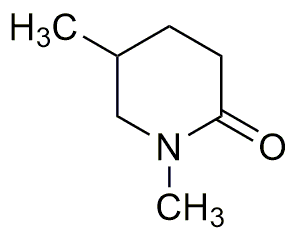1,5-Dimethyl-2-piperidone is widely utilized in research focused on:
- Pharmaceutical Development: This compound serves as an important intermediate in the synthesis of various pharmaceuticals, particularly in creating analgesics and anti-inflammatory drugs.
- Agrochemical Production: It is used in formulating pesticides and herbicides, enhancing their effectiveness and stability, which is crucial for agricultural applications.
- Polymer Chemistry: The compound acts as a building block in the production of specialty polymers, contributing to materials with improved properties like durability and resistance to degradation.
- Flavor and Fragrance Industry: 1,5-Dimethyl-2-piperidone is utilized in the synthesis of flavoring agents and fragrances, providing unique aromatic profiles that enhance consumer products.
- Research in Organic Synthesis: It serves as a versatile reagent in organic synthesis, allowing researchers to explore new chemical reactions and develop innovative compounds.
General Information
Properties
Safety and Regulations
Applications
1,5-Dimethyl-2-piperidone is widely utilized in research focused on:
- Pharmaceutical Development: This compound serves as an important intermediate in the synthesis of various pharmaceuticals, particularly in creating analgesics and anti-inflammatory drugs.
- Agrochemical Production: It is used in formulating pesticides and herbicides, enhancing their effectiveness and stability, which is crucial for agricultural applications.
- Polymer Chemistry: The compound acts as a building block in the production of specialty polymers, contributing to materials with improved properties like durability and resistance to degradation.
- Flavor and Fragrance Industry: 1,5-Dimethyl-2-piperidone is utilized in the synthesis of flavoring agents and fragrances, providing unique aromatic profiles that enhance consumer products.
- Research in Organic Synthesis: It serves as a versatile reagent in organic synthesis, allowing researchers to explore new chemical reactions and develop innovative compounds.
Documents
Safety Data Sheets (SDS)
The SDS provides comprehensive safety information on handling, storage, and disposal of the product.
Product Specification (PS)
The PS provides a comprehensive breakdown of the product’s properties, including chemical composition, physical state, purity, and storage requirements. It also details acceptable quality ranges and the product's intended applications.
Certificates of Analysis (COA)
Search for Certificates of Analysis (COA) by entering the products Lot Number. Lot and Batch Numbers can be found on a product’s label following the words ‘Lot’ or ‘Batch’.
*Catalog Number
*Lot Number
Certificates Of Origin (COO)
This COO confirms the country where the product was manufactured, and also details the materials and components used in it and whether it is derived from natural, synthetic, or other specific sources. This certificate may be required for customs, trade, and regulatory compliance.
*Catalog Number
*Lot Number
Safety Data Sheets (SDS)
The SDS provides comprehensive safety information on handling, storage, and disposal of the product.
DownloadProduct Specification (PS)
The PS provides a comprehensive breakdown of the product’s properties, including chemical composition, physical state, purity, and storage requirements. It also details acceptable quality ranges and the product's intended applications.
DownloadCertificates of Analysis (COA)
Search for Certificates of Analysis (COA) by entering the products Lot Number. Lot and Batch Numbers can be found on a product’s label following the words ‘Lot’ or ‘Batch’.
*Catalog Number
*Lot Number
Certificates Of Origin (COO)
This COO confirms the country where the product was manufactured, and also details the materials and components used in it and whether it is derived from natural, synthetic, or other specific sources. This certificate may be required for customs, trade, and regulatory compliance.


